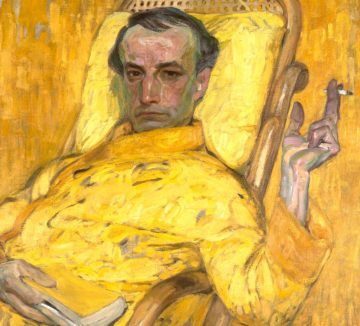Samuel Rutter in The Paris Review:
 I’m not ashamed to say that I bought Joris-Karl Huysmans’s Against Nature because of the cover: Frantisek Kupka’s The Yellow Scale (Self-Portrait) from 1907 is an exhilarating study of the color yellow. Its human subject, slouched in a wicker armchair, a cigarette dangling from one hand while a single, louche finger marks the page of a book, could be the perfect image of Des Esseintes, the dissolute antihero of Huysmans’s novel. Strictly speaking, the painting is a self-portrait of the habitually mustached Kupka, but it bears more than a passing resemblance to Charles Baudelaire, who haunts almost every page of Against Nature. This novel, about a dyspeptic aesthete who “took pleasure in a life of studious decrepitude,” spends some two hundred pages luxuriating in excess and opulence while the hero cuts himself off from the rest of society.
I’m not ashamed to say that I bought Joris-Karl Huysmans’s Against Nature because of the cover: Frantisek Kupka’s The Yellow Scale (Self-Portrait) from 1907 is an exhilarating study of the color yellow. Its human subject, slouched in a wicker armchair, a cigarette dangling from one hand while a single, louche finger marks the page of a book, could be the perfect image of Des Esseintes, the dissolute antihero of Huysmans’s novel. Strictly speaking, the painting is a self-portrait of the habitually mustached Kupka, but it bears more than a passing resemblance to Charles Baudelaire, who haunts almost every page of Against Nature. This novel, about a dyspeptic aesthete who “took pleasure in a life of studious decrepitude,” spends some two hundred pages luxuriating in excess and opulence while the hero cuts himself off from the rest of society.
An old idea that persists about the novel is that it ought to be morally instructive in some way, that it should teach us the correct way to live. Certainly, when Against Nature was published in French in 1884, much of the resultant hand-wringing was because Huysmans’s hero learns nothing new from his misadventures in self-isolation. The problem, according to Émile Zola, was “that Des Esseintes is as mad at the start as he is at the end, that there is no form of progression.”
More here.
